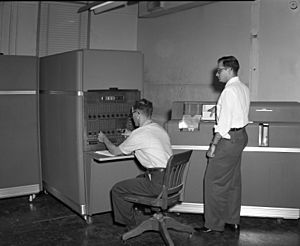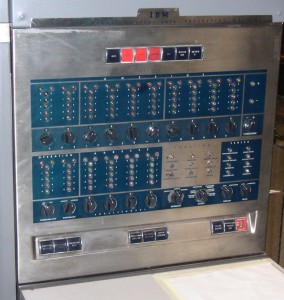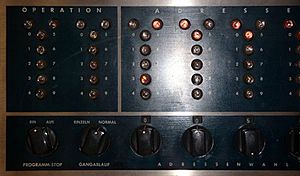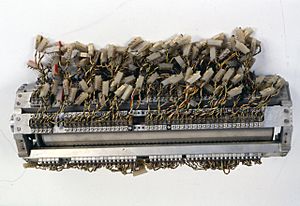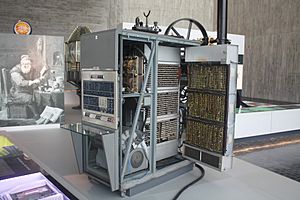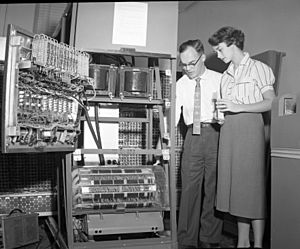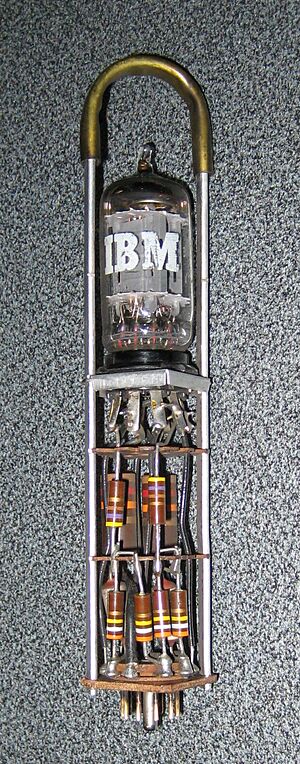IBM 650 facts for kids
 |
|
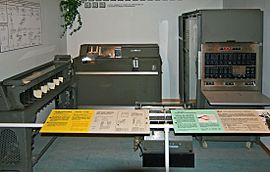
Part of the first IBM 650 computer in Norway (1959), known as "EMMA". 650 Console Unit (right, an exterior side panel is open), 533 Card Read Punch unit (middle, input-output). 655 Power Unit is missing. Punched card sorter (left, not part of the 650). Now at Norwegian Museum of Science and Technology in Oslo.
|
|
| Type | Digital computer |
|---|---|
| Release date | 1954 |
| Predecessor | IBM CPC (604, 605) |
| Successor | IBM 7070 (hi-end) IBM 1620 (low-end) |
| Related articles | IBM 701, IBM 702; IBM 608 |
The IBM 650 Magnetic Drum Data-Processing Machine was an early digital computer made by IBM in the mid-1950s. It was a very important machine because it was the first computer to be mass-produced. Almost 2,000 of these systems were built, with the last one made in 1962.
The IBM 650 was also the first computer that made a lot of money for its creators. The first one was set up in late 1954. It quickly became the most popular computer throughout the 1950s.
IBM sold the 650 to businesses, scientists, and engineers. It was a general-purpose computer, meaning it could do many different tasks. It was also a great upgrade for companies already using older punched card machines.
Because it was not too expensive and fairly easy to program, the IBM 650 was used for many new things. People used it for everything from studying how submarine crews performed to teaching computer programming in schools. It became very popular in universities, where many students learned how to code for the first time.
The IBM 650 was first announced in 1953. In 1956, it got an upgrade called the IBM 650 RAMAC. This new version could have up to four disk storage units. In 1959, the basic IBM 650 console cost $150,000. That's like $1,500,000 in today's money! IBM stopped supporting the 650 and its parts in 1969.
The 650 used a special way of handling numbers called "bi-quinary coded decimal." Both its data and memory locations used decimal numbers. Its main memory was stored on a spinning magnetic drum. The computer could understand letters and special symbols by converting them from punched cards into a two-digit decimal code.
The IBM 650 ran at a speed of 125 kHz. It could add or subtract numbers in about 1.63 milliseconds. Multiplying took about 12.96 milliseconds, and dividing took 16.90 milliseconds. On average, the 650 could do about 40 instructions every second.
Contents
History of the IBM 650
The very first IBM 650 was set up on December 8, 1954. It was installed in the accounting department of the John Hancock Mutual Life Insurance Company in Boston.
Later, IBM released new computers that were meant to replace the 650. The IBM 7070 was announced in 1958. The IBM 1620, introduced in 1959, was for smaller users. Other companies also made computers to compete with the 650, like the UNIVAC Solid State from Sperry Rand. However, none of these new computers could run the same programs as the IBM 650.
What Made Up the IBM 650?
The basic IBM 650 system came with three main parts:
- The IBM 650 Console Unit: This part held the magnetic drum memory, the arithmetic unit (which used vacuum tubes), and the controls for the operator.
- The IBM 655 Power Unit: This unit supplied power to the computer.
- The IBM 533 or IBM 537 Card Read Punch Unit: This unit was used to read information from punched cards and punch new information onto them. The IBM 533 had separate slots for reading and punching cards. The IBM 537 used one slot to read a card and then punch new data onto the same card.
The whole system was quite heavy, weighing between 5,400 and 6,263 pounds (about 2,449 to 2,841 kilograms).
Extra Parts You Could Add
You could also add other units to the IBM 650 to make it do more things:
- IBM 46 Tape To Card Punch
- IBM 47 Tape To Card Printing Punch
- IBM 355 Disk Storage Unit: Systems with this unit were called IBM 650 RAMAC Data Processing Systems.
- IBM 407 Accounting Machine
- IBM 543 Card Reader Unit
- IBM 544 Card Punch Unit
- IBM 652 Control Unit: This helped connect magnetic tape and disk drives.
- IBM 653 Storage Unit: This added more memory and features like floating-point arithmetic.
- IBM 654 Auxiliary Alphabetic Unit
- IBM 727 Magnetic Tape Unit
- IBM 838 Inquiry Station
How the Memory Worked
The main memory of the IBM 650 was a spinning drum memory. It could store 1,000, 2,000, or 4,000 "words" of information. Each "word" had 10 decimal digits. This could be a 10-digit number or five characters.
The drum spun very fast, at 12,500 revolutions per minute (rpm). This meant the computer had to wait for the right part of the drum to spin around to read or write data. To make programs run faster, programmers would carefully place instructions on the drum so the next instruction was ready right when the previous one finished.
Later, a program called SOAP (Symbolic Optimal Assembly Program) was created. It helped programmers arrange instructions more efficiently.
The 650 had a special "accumulator" that could hold 20 digits. This was used for calculations. The computer also had a console with lights and switches that operators could use to interact with it.
The IBM 653 Storage Unit
The IBM 653 Storage Unit was an optional part introduced in 1955. It added several important features:
- Magnetic Tape Controller: This allowed the 650 to use IBM 727 Magnetic Tape units for storing more data.
- Disk Storage Controller: Added in 1956, this let the 650 connect to the new IBM 355 Disk Storage Unit.
- Fast Memory: It included 60 words of magnetic core memory. This "fast memory" was much quicker to access than the drum memory.
- Index Registers: These helped the computer find memory locations more easily.
- Floating Point: This feature allowed the computer to handle very large or very small numbers using scientific notation.
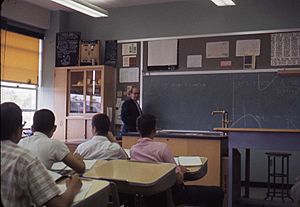
How the IBM 650 Understood Commands
The instructions for the IBM 650 were made up of a two-digit "operation code" (what to do), a four-digit data address (where to find the data), and a four-digit address for the next instruction. The basic machine had 44 different operation codes. If you added all the optional features, the computer could understand 97 different commands.
One interesting command was "Table Lookup" (TLU). It could quickly search through many words on the drum to find a match.
The "Read" (RD) instruction would read information from an 80-column punched card into the computer's memory. The way the card was wired determined where the numbers went in memory.
Software for the IBM 650
Many different types of software were created for the IBM 650:
- Symbolic Optimal Assembly Program (SOAP): This was an assembler, which helped programmers write code using symbols instead of just numbers.
- Technical Assembly System (TASS): A more advanced assembler.
- Bell Labs Interpretive System (BLIS): This allowed the 650 to run programs written in a simpler way.
- Internal Translator (IT): This was a compiler, which translated high-level programming languages into machine code.
- Revised Unified New Compiler IT Basic Language Extended (RUNCIBLE): An improved version of IT.
- FOR TRANSIT: A version of Fortran, a popular programming language, that worked with IT.
- FORTRAN: The full version of the Fortran programming language.
- GATE: A simple compiler.
- IPL: This was one of the very first languages designed for "list processing," which is important for artificial intelligence.
- SPACE (Simplified Programming Anyone Can Enjoy): A business-focused compiler.
Donald Knuth's famous series of books, The Art of Computer Programming, is dedicated to the IBM 650.
Images for kids
See also
 In Spanish: IBM 650 para niños
In Spanish: IBM 650 para niños
- Ferranti Mark 1
- History of IBM#1946–1959: Postwar recovery, rise of business computing, space exploration, the Cold War
- IBM 700/7000 series
- Bull Gamma 3, one of the main competitors to the IBM 650
- LEO (computer)
- List of vacuum-tube computers
- Short Code
- UNIVAC I
- UNIVAC Solid State announced by Sperry Rand in December 1958 as a response to the IBM 650. In June 1959, Remington Rand announced that it had written an IBM 650 emulator program to ease conversion.


